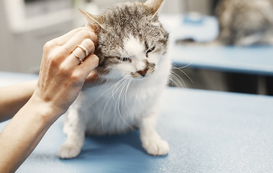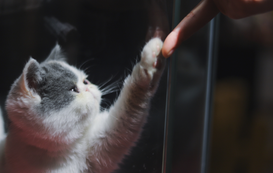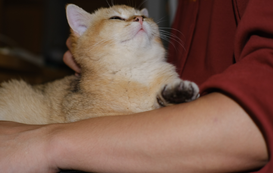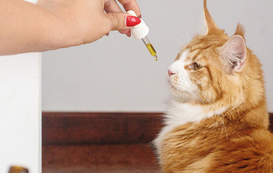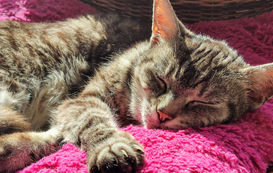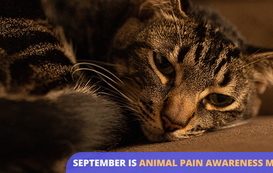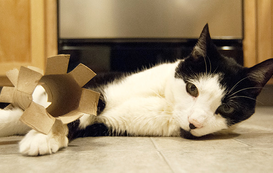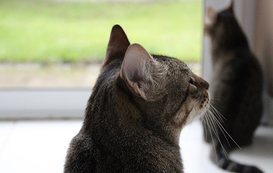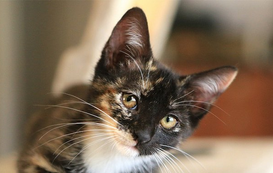- Home
- Cat Sitter Blog
- Cat Behavior
- How to Handle a Scaredy Cat
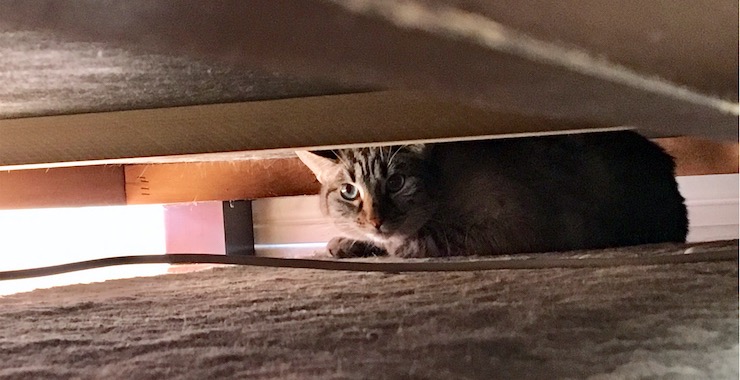

How to Handle a Scaredy Cat
Like people, cats have very different purrsonalities as well as fear and anxiety thresholds. Some cats are social catterflies, fluttering about to rub their heads on anyone who will give them attention. Others are introcats (introverts), who may have some sort of social or separation anxiety. Our household is a mix; my cat is a social catterfly, and I am an introcat, so to speak.
As a cat sitter, you will likely come across several scaredy cats. Here are some handy tips to help keep those kitties get comfortable and give them the best care possible.
Know What You’re Dealing With
Let me tell you, I've been around cats since the minute I came out of the womb, and there are so many different cat personalities. Cat parents will know exactly where their cat falls on the scaredy cat spectrum. So, as a great sitter, make sure you inquire about specifics during your Meet & Greet.
You should be able to get a feel for the cat during your Meet & Greet even before asking the parent. Does the cat come up to you immediately looking for love? Do they hide throughout the whole visit? Do they come out only to hiss, growl, and slap at you, the stranger? Chances are, if they are aggressive toward you, it’s because they are terrified. Of course, there is a chance that the cat is a devil child, or more likely they may have some feral genes in them. But it’s often fear coming out as anger. It's like when people lash out with mean words; they might do so because they are hurting, embarrassed, or scared.
During your Meet & Greet, be sure to ask the questions outlined in the blog “How To Become A Top Notch Sitter, Part 1,” including the ones about the cat’s purrsonality. It is crucial that as a sitter you get all the correct information about the cat's behaviors and tendencies from the cat parent. If you don't feel like you have enough information for a smooth visit, ask the cat parent to clarify or give more details. The more you know, the better equipped you will be at handling any scaredy cat situation.
Locate Their Spot
Now, fast forward to your visits with the cat. If you have a bona fide scaredy cat and they do not come out of hiding at all during your visit, be sure to check every spot you were told about. Most cats have a specific hiding spot (under the bed, in the closet, etc.), but truly terrified cats may change their hiding spots after you’ve figured them out. By asking the cat parent at your Meet & Greet the specifics on all their cat's hiding places, you won't be thrown off if the cat ends up in some unusual places. Of course, it's the best practice to get permission from the cat parent to find their cat–especially if they are in armoires, dressers, or closets. Otherwise, it will look like you are rifling through their things. (And you know it will be caught on camera!)
Know Their Type
Parents of scaredy cats tend to fall into two categories. One type will say, “Don’t stress my cat out any more than they already are. Please come over just to feed and clean.” This parent may also tell you that you don’t have to stay much longer than the time it takes to do your cleaning and feeding duties as your presence alone may make the cat more scared. If this is the case, take photos of the food and litter area so they know you've been there and did what was asked. Stay in the same area as the cat but leave them be. I tend to stay within five to six feet within their eye line so they know I’m there and not a threat. I’ll talk to the cat, but I won’t try to interact with them much more than that. Here’s my silly little secret: I will often read them an article from Buzzfeed or make up songs to sing to them. I want the cat to feel comfortable and trust me; I don’t want to send them into a full-blown anxiety attack. This trick is when it’s acceptable to be on your phone or watching TV if it’s in the same room as the cat.
The other type of cat parents will want you to try to interact with their kitty. If that’s the case, use all the tricks the parent told you at the Meet & Greet. The key to doing this, though, is in a calm fashion. Don’t be running around the house yelling the cat’s name, shaking treats. That will scare the crap out of them.
Approach the situation gently. Walk slowly. Call the cat’s name out calmly. Try sitting on the floor so you are on their level, not terrorizing them from above. Approach the potential hiding spot with caution. If you’re able to find the cat but the cat is refusing to come out of hiding, take photos of the cat the best you can. The parents will appreciate the effort and update even if you just get 2 reflective eyes from under the bed. If getting a picture of the cat in their hiding place is impossible (or it's just reflective eyes), take photos of their food area and litter box instead. Giving excessive details about what you tried, where you looked, and how the cat reacted in your update will put the cat parent more at ease. Details and photos matter when it comes to scaredy cats!
Do the Best You Can
You won’t be able to win over and become BFFs with every cat. As long as you show the cat love, even if it’s from a distance, the cat parent will be happy. It’s all about how you handle the situation. The more knowledge you have about the cat and the cat parent’s expectations with their shy baby, the better you’ll be able to handle the situation and make it a win-win-win for all furry and non-furry beings involved.
You can find more tips and case studies from some of our top cat sitters on the Meowtel blog!
Meowdel: Leo Kim-Ahn









